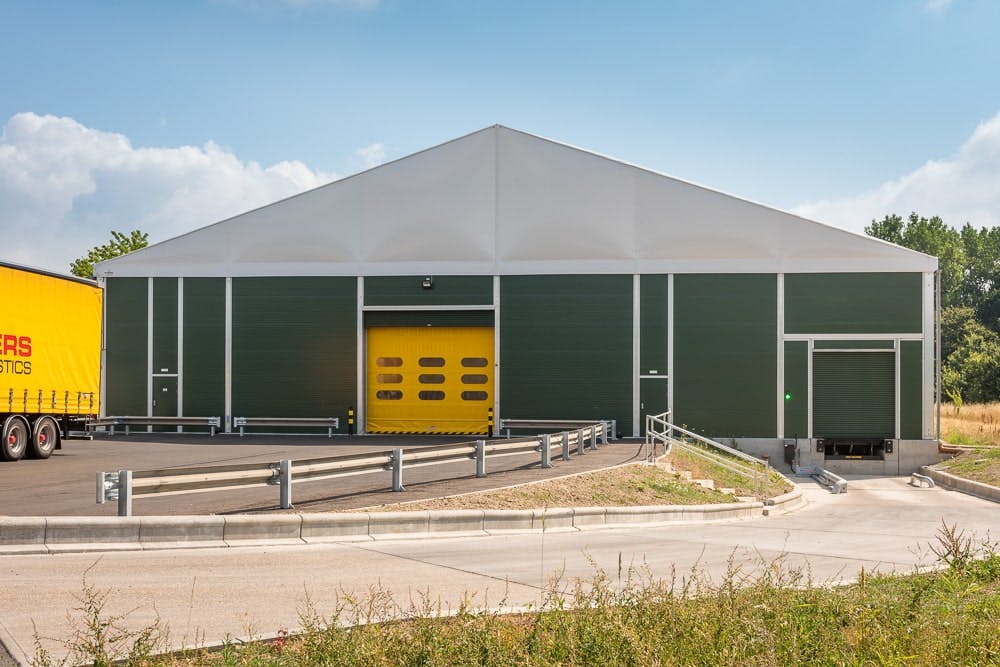Options for Overflow Warehousing
If your business needs to accommodate overflow warehousing there are multiple options available. What are they though and which is right for your business?
This article considers containers, leasing off-site, reorganisation, relocation and temporary buildings, alongside key requisites of speed, period of use, suitability and cost.
Containers are for hire or sale and around 8ft – 40ft long. There is usually a large volume available, which is reflected in the lower prices.
This easy and affordable option can present problems though.
Rusty metal containers don’t perhaps reflect the company image you want to portray to customers or employees. Furthermore, trying to adapt the unit so it’s fit for purpose can change an easy solution into a time-consuming headache.
Shelving might be needed so sensitive items can go lower down to avoid condensation drips. Insulation and ventilation may be required, so using the container in the summer or winter doesn’t become an uncomfortable imposition for you or your staff.
Lastly, even with multiple stacked units, they often aren’t large enough. In this event, leasing space off-site might be better.
Local, suitable off-site space with flexible pricing and terms can often be quickly found.
If you’re moving some of your inventory though, the biggest challenge might be managing it over multiple sites.
Outsourcing the supply chain management for your overflow needs full integration with your IT systems. And, finding a supplier that can match your standards in areas of staffing, quality, efficiency, delivery times and environmental values, could be challenging.
Managing the overflow yourself gives you control, but will probably create additional transport costs, associated emissions and extra travelling time; potentially making your operation less efficient.
On paper, off-site warehousing looks straightforward. In reality, it needs a lot of research and planning.
If your overflow warehousing looks like a long-term problem, it’s prudent to explore relocation possibilities.
Workforce, investment and customer communication all need careful consideration, as does IT.
Relocating your IT system can, at best, be frustrating and at worst a commercial disaster. It must be placed in to careful trusted hands.
Customers and staff will lose patience with delays getting back to 100% efficiency.
However, evaluating all issues and options before a relocation is forced on you can only be beneficial.
Perhaps before making any decision on overflow warehousing, it’s worth reviewing your existing operation.
The options to maximise and optimise all available warehouse space are as many as the companies offering the improvements.
Racking, shelving, use of height, depth, slot size and aisle width can all be reassessed.
Installing temporary buildings on site can also create significant opportunity for reorganisation.
Temporary buildings
This is a flexible option that comes with hire or buy contracts and combines most of the above pros and few of the cons.
Unlike a shipping container, a temporary building comes with various cladding options for insulation and colour options to match branding.
The turnaround of shipping containers and off-site leasing can be matched as temporary buildings require no foundations and can usually be installed in 4/5 days; meaning your overflow could be securely stored on site within weeks.
Buildings are much larger than shipping containers, up to 30m width and 6m wall height as standard, with unlimited lengths and the ability to link them together or to your existing warehouse.
Temporary buildings are also engineered with the same structural safety standards as a leased warehouse, ensuring long-term use if you wanted to purchase one.
If you’re using some of your existing warehouse space as a workshop or for equipment storage, you can relocate these into temporary buildings, freeing up maximum warehouse space for inventory. This project demonstrates using a temporary warehouse extension building to free up existing warehouse space.
Additionally, choosing temporary buildings as an interim option gives breathing space to consider relocation and reorganisation.
Right option for your business?
Whatever option you choose for your overflow warehousing, there is ample information available to help you decide.
Fundamentally though, most options provide interim solutions. This ensures the overflow is accommodated leaving you to consider the broader, long-term picture.
Our configurator tool allows you to design your structure to suit your needs. Design your ideal structure and see how it will look in less than 3 minutes! Receive an estimate and copy of your configuration.
